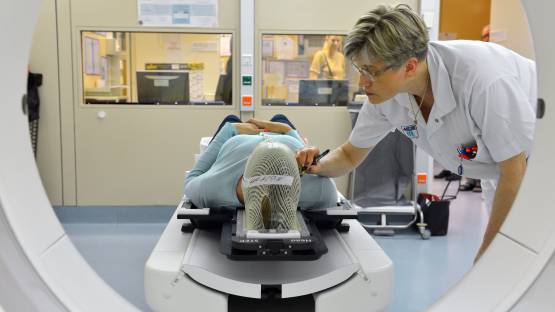The IAEA is launching a new Coordinated Research Project (CRP) aimed at investigating the potential of artificial intelligence (AI) to enhance contouring skills in radiotherapy, especially focusing on increasing accuracy of delineation of organs at risk in head and neck cancers.
Radiation oncology has evolved rapidly in recent decades in terms of innovations in treatment equipment, volumetric imaging, information technology and increased knowledge in cancer biology. New delivery technologies and associated imaging modalities have enabled highly optimized precision radiation therapy and contributed to improvements in tumor control and cancer patient cure.
The selection and contouring of target volumes and organs at risk (OARs) has become a key step in modern radiation oncology. Concepts and terms for definition of gross tumor volume, clinical target volume and OARs have been continuously evolving and have become widely disseminated and accepted by the international radiation oncology community. However, clinical research from single institutions and multicentre experiences has provided evidence for major variations in contouring for both target volumes and OARs.
In recent years, AI-based methods, such as deep learning, have improved auto-segmentation drastically. It is generally believed that the use of such tools will lead to lower the inter-observer variation and time savings for clinical staff. A wide palette of commercial deep learning-based auto-segmentation solutions are emerging with the promise of leveraging the aforementioned benefits.
While the objective performances for deep learning-based auto-segmentation in retrospective studies are very promising, the actual clinical benefit is largely unstudied. Studies have shown that deep learning-based auto-segmentations of OARs for head and neck cancer still requires manual adjustments, and that there is a continuous need to educate radiotherapy specialists in delineation guidelines despite clinical implementation of deep learning-based auto-segmentation. Little, however, is known about how implementation of auto-segmentation tools will affect delineation practices in the short and long term. Previous research has made it clear that instructor-led guideline workshops are effective in reducing the inter-observer variation, however, it is unknown if and how the introduction the auto-segmentation modifies this causation.
CRP Overall Objective
This proposed new CRP on The Potential of E-Learning Interventions for AI-assisted Contouring Skills in Radiotherapy has the overall objective of investigating changes in inter-observer variation and bias after E-Learning in delineation guidelines, as well as the use of deep learning-based auto-segmentation of organs at risk in head and neck cancer.
Specific Research Objectives:
- To train multidisciplinary teams to contribute to the goal of high-quality 3D radiotherapy
- To investigate the consequences of introducing AI-assisted contouring without prior training and education
- To examine the effect of training and education on AI-assisted contouring skills
- To examine if the effects of AI assistance on contouring skills are retained in the long term
Inclusion Criteria
Radiotherapy centres will be enrolled according to the following inclusion criteria:
- Located in a low- or middle-income country
- Treats at least 20 head and neck patients per year
- Has 3D radiotherapy with CT-based planning, regardless of whether contrast is used
- Robust internet connection for online workshop participation and case up- and download
- Can provide at least 4 oncologists as participants
How to join this CRP?
Research organizations interested in joining the CRP must submit their Proposal for Research Contract or Agreement by email, no later than 30 June 2022, to the IAEA’s Research Contracts Administration Section, using the appropriate template on the CRA web portal. Same template can be used for both research contracts and technical contracts. The IAEA encourages institutes to involve, to the extent possible, female researchers and young researchers in their proposals.
Potential applicants can use the contact form for further information related to this CRP.





